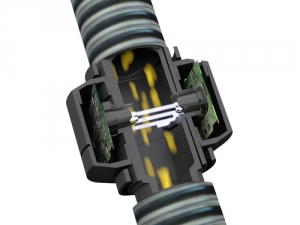New seed drill tech coming
Incorporating Vaderstad's latest seed drill technology, the Proceed V 24, is said to improve precision and increase planting efficiencies for New Zealand farmers and growers from the 2026 season.
 The measurement of seed volume is said to be 99% accurate in rape and 98-99% in cereal seeds with a rate of 250 seeds per second.
The measurement of seed volume is said to be 99% accurate in rape and 98-99% in cereal seeds with a rate of 250 seeds per second.
Drill specialist Vaderstad has announced a new unique technology called SeedEye.
The system allows farmers to easily set the number of seeds required per square metre without the need for any calibration tests.
The company says counting seeds is far more exact then calculating quantity based on seed weight and it has been developed after customer requests to be able to predict total plants per square metre.
Units comprising six optical sensors illuminated by infra-red light are placed in the seed tubes. As seeds pass the light rays there is a momentary interruption which is recorded by an optical transistor.
The total number of 'breaks' is registered and processed, resulting in a measurement of seed volume said to be 99% accurate in rape and 98-99% in cereal seeds with a rate of 250 seeds per second.
The system is also said to be fully automatic and takes into account any dust or residue that might build up on the sensors.
In practice, the operator sets the desired seed volume per square metre with an iPad and without the need for a conventional style calibration test.
The drill’s radar measures forward speed, and works with the E-Control to continuously achieve the set-point with information being received from the SeedEye sensors. If the operator wishes to change the seeding rate, this is easily done via the iPad and happens instantaneously regardless of the tractor's forward speed.
The system is currently available for Vaderstad Rapid A 400-800S and Rapid A 600-800C drill units.
Dairy prices have jumped in the overnight Global Dairy Trade (GDT) auction, breaking a five-month negative streak.
Alliance Group chief executive Willie Wiese is leaving the company after three years in the role.
A booklet produced in 2025 by the Rotoiti 15 trust, Department of Conservation and Scion – now part of the Bioeconomy Science Institute – aims to help people identify insect pests and diseases.
A Taranaki farmer and livestock agent who illegally swapped NAIT tags from cows infected with a bovine disease in an attempt to sell the cows has been fined $15,000.
Bill and Michelle Burgess had an eye-opening realisation when they produced the same with fewer cows.
It was love that first led Leah Prankerd to dairying. Decades later, it's her passion for the industry keeping her there, supporting, and inspiring farmers across the region.

OPINION: The release of the Natural Environment Bill and Planning Bill to replace the Resource Management Act is a red-letter day…
OPINION: Federated Farmers has launched a new campaign, swapping ‘The Twelve Days of Christmas’ for ‘The Twelve Pests of Christmas’ to…